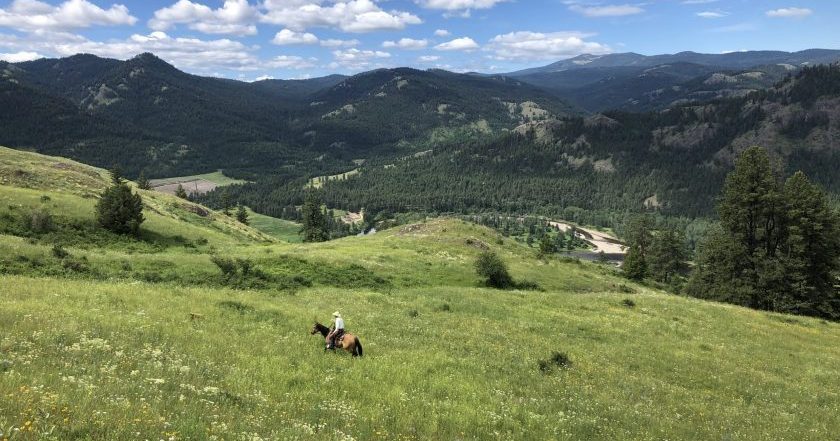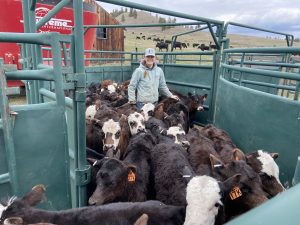AB Direct - Steers
Rail: 495.00 del
AB Direct - Heifers
Rail: 495.00 del
US Trade- Steers
Rail: 355.00-363.00 (IA, NE)
US Trade - Heifers
Rail: 355.00-363.00 (IA, NE)
Canadian Dollar
0.05

National TESA Recipient for 2022: Bar 7 Ranch
For the Fossen family of south central British Columbia (B.C.), applying proper stewardship to forage and water management on their private land as well as Crown range pastures not only benefits the environment, it makes good business sense for their ranching operation.
As the second and third generation on the Bar 7 Ranch near Rock Creek in B.C.’s Kootenay Boundary Region, Doug and Erika Fossen, along with daughters Adele, Jade, and Reine, have been applying their best management practices to optimize forage production on deeded, rented, and leased land for the past 25 years. That management has helped to provide stability to the ranching operation through market and weather ups and downs.

Award Recipients
Those management practices earned the Fossen Family recognition as the recipients of The Environmental Stewardship Award (TESA) presented by the Canadian Cattle Association on August 17 at the Canadian Beef Industry Conference (CBIC) in Penticton, B.C.
“We hope to showcase some of the positive environmental benefits our industry supplies, giving future generations a chance to continue ranching across our great country,” says Doug Fossen.
The Fossen Bar 7 Ranch west of Rock Creek, and about 42 km east of Osoyoos was started by Doug’s parents, Ed and Louise Fossen, in 1976. Doug and Erika met during their studies of Agricultural Business at Olds College in Alberta and after graduation in 1998 they returned to the Fossen farm in B.C. and later began the transition of the ranch business from his parents to the next generation. Ed and Louise Fossen continue to live on the ranch and are still involved, although mostly retired.
Today, the Bar 7 Ranch includes about 2,300 acres of deeded land, which supports a 350-head commercial cow-calf herd along with 80 replacement heifers and 18 bulls, and backgrounds about 100 calves each winter.
The 600-acre timbered area of the ranch is carefully managed.
Selective logging practices open up areas to improved forage growth.
They also rent some private pasture and hold grazing leases on about 19,000 acres of Crown Land in the Rock Creek and Midway area. The private land includes about 600 acres of timbered, rough native grazing land along with about 150 acres of old hay fields that get grazed. In addition, they have about 250 acres of irrigated land, leaving roughly 1,500 acres of native grassland.
Grazing Management
Over the years, the Fossens have developed a rotational grazing system. “Our plan is to use each pasture only once, giving the grasses plenty of time to recover,” says Fossen. “Depending on the year and growing conditions, we may graze some a second time, but ideally it is only once.”
That approach also applies to managing the creek side riparian areas on the ranch. In some areas they have off-site watering systems set up, which encourage cattle to drink from a trough rather than the creek, while other riparian areas are used for grazing late in the season after the ground is frozen.
The summer grazing season usually ends in late September with cow-calf pairs brought home and placed on alfalfa hay field regrowth. Calves are sold through online sale and remain on the farm until weaning and delivery to buyers in late October. About 220 steer and heifer calves are sold to feedlots, while another 110 head remain on the farm. Between 50 and 80 heifers will be kept as replacement, while the rest are backgrounded over winter to be sold as grassers the following spring.

The ranch has about 200 acres of irrigated cropland, watered by five small pivot irrigation systems as well as some hand-move irrigation pipe.
An overall philosophy of the ranch is to properly manage the forage resources to not only benefit beef production but also to benefit wildlife habitat. There is an extensive weed management program on the ranch to control invasive weed species.
The 600-acre timbered area of the ranch is carefully managed. Selective logging practices open up areas to improved forage growth. Properly managed livestock grazing makes use of the grass and helps to clear some of the undergrowth and mitigate wildfire hazards in and around their ranch. Being able to utilize these areas for grazing helps lessen the pressure on their fragile natural grasslands.
The Bar 7 Ranch is home to diverse wildlife such as whitetail and mule deer, elk, moose, bobcat, cougar, coyote, bear, badger, marmot, mountain bluebird, northern pygmy owl, tiger salamander, Lewis’s woodpecker, fox, bald eagle, and wolf.
The Fossens believe they have a responsibility to the wildlife in their area and do their best to ranch in a way that enhances healthy habitat for them, while also caring for their beef herd.
Over the years, the ranch has partnered with both Ducks Unlimited Canada (DUC) and the B.C. Ministry of Forests. Under their partnership with DUC, they were able to install an off-stream water trough and five more water troughs on range with the Ministry of Forests.
“Looking ahead, our goal is to continue to improve forage production on the ranch,” he says. “We will be looking at ways to improve efficiency perhaps through a more intensive grazing system. Our motto is farming for big production on a small acreage using tools such as zero till, proper crop rotation and diversity, and properly managed fertility. We’re looking to lower equipment costs and reduce water use while having more pasture for the cattle.”
This article was first published in Volume 2 Issue 4 of ABP Magazine (October 2022). Watch for more digital content from the magazine on ABP Daily.

